Aug
14
SETH THOMAS Mantel Antique Clock c/1913 Model PROSPECT No. 2 Totally Restored

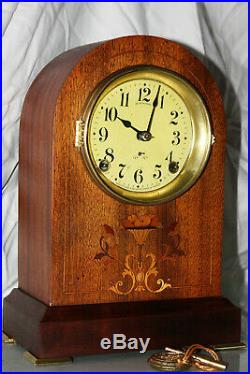
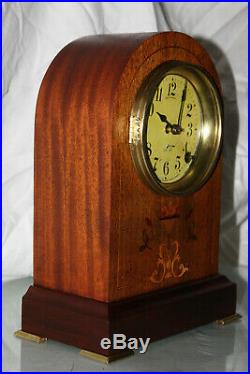
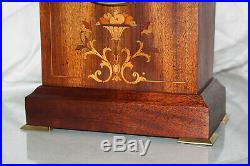
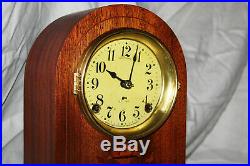
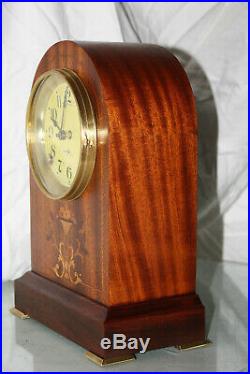
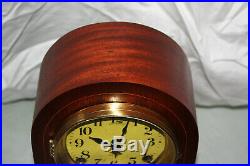
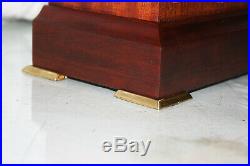

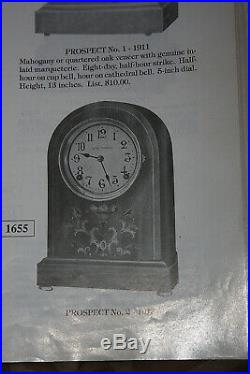
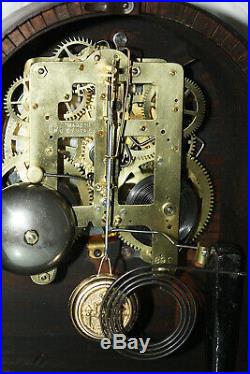
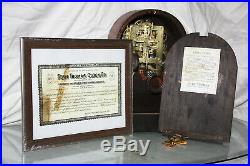

Seth Thomas Alarm Series Clock. Model ” PROSPECT No 2″ -1913 VERY CUTE BEAUTIFUL CLOCK- Mahogany Veneer,,, also for decoration You Room or Holley. Clock chimes the Hours counting them and every 1/2 hour, You also can see on picture how all clock is clean after cleaning including mechanism. Clack has nice Tick-Tack sound of work. I will including instructions! Movement is marked with ST-(SETH THOMAS), Clock measures 8 3/4″ Base x 5″ deep x 12 3/4 height. Roman Original Brass Face with Original Face in very – Excellent Conduction is 5 in diameter. Every piece on this clock is original. This clock is made of Mahogany Veneer Panels. I will include a copy of ST”Guarantee Certificate”. This particular is just a token of it’s beauty and originality in past, People love to see something old, which comes with the style and elegance of the beginning 20th century, AMAZING. Please feel free to contact me with any questions or to request further photos! Pendulum and key is included with the clock. The clock is running perfect!!!!!!! . This is unusual Clock, hard to find on any Auctions and is keeping by Colectioners in Houses, The clock has original surface nothing is painted or re coated, just some touch up was done. Clock is original was polished and clean from dirt to original finish. —PLEASE SEE MY OTHERS CLOCKS FOR SALE!!!! See my others clocks for sale. Seth Thomas Clock Company History Plymouth Hollow, Connecticut (After 1865) Thomaston, Connecticut Seth Thomas Seth Thomas was born in Wolcott, Connecticut in 1785, the fifth of seven children of Scottish immigrant, James Thomas, a cooper, and his wife Maria Ward. Connecticut, incidentally, was an important and expanding hub in the American clockmaking trade. Seth Thomas Childhood Home, 36 Peterson Ln photo above c. 1984 – link to c. 2005 photo He was born in this house and lived there until about 1810. Current Photo Current Map Seth had a natural ability for carpentry and he probably obtained his knowledge and interest in mill property and manufacturing from this. He had imited formal education and left school at an early age to become an apprentice carpenter and joiner to Daniel Tuttle, of Plymouth. Subsequently, he became a skilled woodworker and built houses and barns in the nearby towns around Farmingbury/Wolcott (incorporated 1796). In the early 1800s, Seth attempted to set up a clock-making industry in Wolcott. He made his first clock in his family’s house. The woods around the house were filled with mountain laurel trees; many Wolcott men worked cutting the trees and sawing them into thin slices, which, when seasoned, were used for the wooden wheels of the clocks. The women of the town spun flax (cotton) into cords and these were used to hold the clock weights. As a result, the town of Wolcott profited to some extent from the Thomas enterprise, the short time it was located in Wolcott. In 1807, Seth moved to Plymouth. There he joined Eli Terry and Silas Hoadley in a business of making clocks at a wholesale rate. Seth mainly worked on fitting the wheels and different clock parts together. From 1807 until 1810, they made 4000 clocks of the “hang-up” or “wag-on-the wall” type. These clocks did not have cases, but buyers who wanted cases for their clocks hired carpenters to build what they called “grandfather cases” for them. The land included a clock factory and was conveniently located near Eli Terry’s new shop where was the non-compete agreement? Thomas continued Clarks wooden movement tall clock production, and about 1817 began making the wooden movement shelf clock. These were cased in pillar and scroll cases until 1830, when the bronze looking glass and other styles became popular. In 1842, brass movements were introduced, and first cased in the popular O. Case (which was made until 1913). Wood movements were phased out in 1845. Seth’s first wife was Philinda Tuttle; they married in the early 1800s and had a daughter, Philinda. His second wife was Laura A. They had six children Seth, Martha, Amanda, Edward, Elizabeth, and Aaron. And Aaron went into the clock business with their father, subsequently enlarging the clock factory and developing it into a worldwide business. After Thomas death in 1859, the town of Plymouth CT was renamed “Thomaston” in his honor. At that time, Aaron became President and began to add new products. Huntington and Harvey Platts of Ithaca, New York and added three models to their line that year. The earliest of the clocks indicate only three patent dates on the dials, September 19, 1854, November 17, 1857 and January 31, 1860. The fourth and final patent of March 1, 1862 is carried on most of their calendar clocks manufactured until 1875 or 1876. On February 15, 1876 Randall T. A Thomas relative and workman in the factory, received a patent on an improved mechanism. This was put into production and utilized on all later perpetual calendar clocks until the last model was dropped in 1917. Movement Dept – Thomaston CT Regulator clocks were introduced in 1860. Spring driven clocks were introduced ca. Perpetual calendar clocks were made from ca. Some of the most popular later types include walnut kitchen clocks, made from 18841909; marble clocks, 1887ca. 1895; black (Adamantine finish) wood mantel clocks, ca. 18851917; black enameled iron cased clocks, 1892ca. 1895; oak kitchen clocks, 1890ca. 1915; tambour clocks, introduced in 1904; chime clocks, introduced in 1909; and electric A/C clocks, introduced in 1928. The Seth Thomas Clock Company was very prosperous into the 20th Century and was considered the Tiffanys of Connecticut clock manufacture, even by their competitors. Between 1865 and 1879 they operated a subsidiary firm known as Seth Thomas’ Sons & Company that manufactured a higher-grade 15-day mantel clock movement and during that period were major supporters of a New York sales outlet known as the American Clock Company. Many Seth Thomas clocks from 1881 to 1918 have a date code stamped in ink on the case back or bottom. Usually, the year is done in reverse, followed by a letter AL representing the month. For example, April 1897 would appear as 7981 D. On January 1, 1931, the firm became a subsidiary of General Time Instruments Corporation and soon passed from family control. In 1955, a flood badly damaged the Seth Thomas factory. They phased out movement manufacturing and began importing many movements from Germany. Hermle, in the Black forest of Germany, has made many movements for Seth Thomas clocks. It was reported in 1988 that the firm was all but dissolved. In June 2001 General Time announced that it was closing its entire operation. The Colibri Group acquired Seth Thomas. In January, 2009, The Colibri Group unexpectedly shut its doors, laying off its 280 employees and preparing to sell all remaining jewelry, gold and silver to pay creditors. The following message appeared on the Colibri website: February 16, 2009: The Colibri Group is currently in receivership and is not accepting any orders at this time. We will update this message as new information becomes available. We are sorry for the inconvenience. Thank you for your patience. Seth Thomas Dating Seth Thomas Clocks Some early Seth Thomas clocks can be dated by the address of the printer (Elihu Geer) who printed the labels found inside. If your label is still intact, the printers name and address can be found in small print at the bottom of the label. PLEASE VISIT MY OTHER AUCTIONS. Please note that most of my items are antique/ vintage items and show normal signs of wear and use, such as small nicks and dings, etc. Please check the pictures as they say much more than words. I dont usually list every little nick or ding; the pictures show a much better description. Please do a level to the clock to keeping and running well. Customer service is very important to me. If you have any questions at any point during the purchasing process, please dont hesitate to ask or contact me. Feedback I Strive for 5!! Please give me a chance to resolve any issues. I I want all my customers to be satisfied when they receive their package!! The more communication the less misunderstandings. The item “SETH THOMAS Mantel Antique Clock c/1913 Model PROSPECT No. 2 Totally Restored” is in sale since Monday, August 3, 2020. This item is in the category “Collectibles\Clocks\Antique (Pre-1930)\Shelf, Mantel”. The seller is “edwmi_5239″ and is located in Chicago, Illinois. This item can be shipped to United States.
- Brand: Seth Thomas
- Modified Item: No
- Clock Type: Mantle
